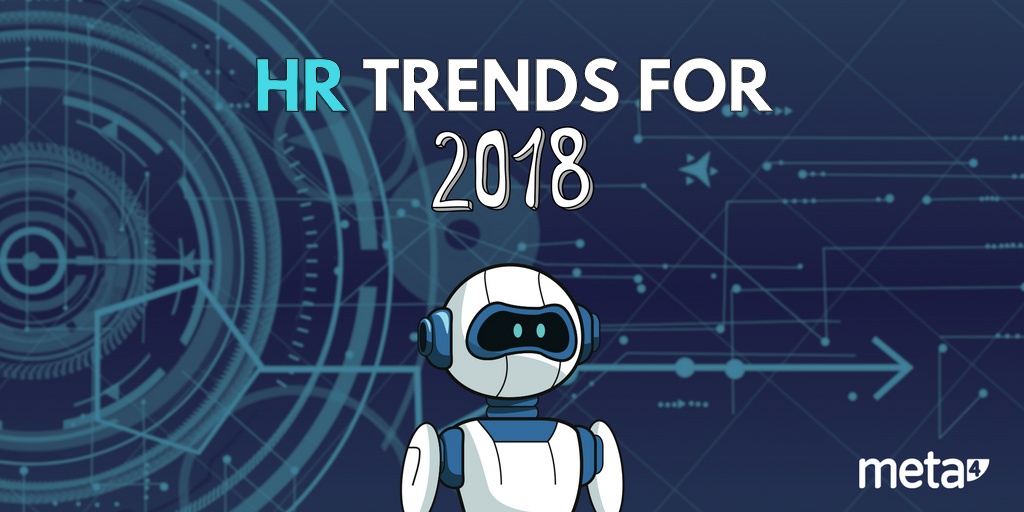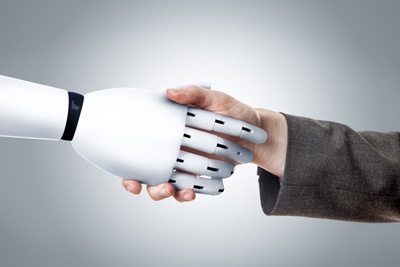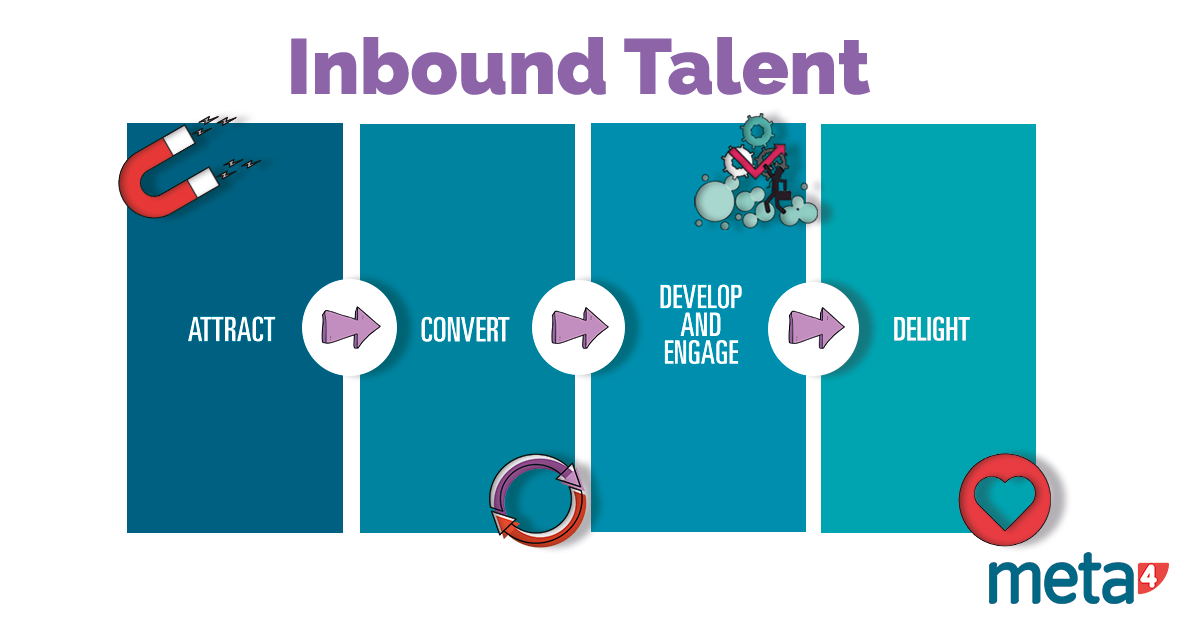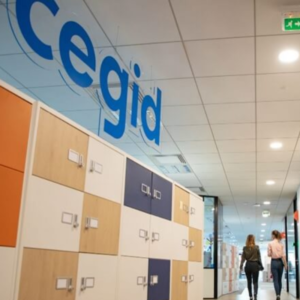Authors: Carolina Reynoso and Bettina Rodríguez Flick
In this article, we discuss two important trends for 2018: the real implications of different types of AI (artificial intelligence) for society and the new philosophy emerging for HR management, Inbound Talent.
2018: Increasingly complex challenges for HR and for other professionals
Are you a little lost with all the changes in recent times? Are you interested in the innovations but concerned about the future of work with the advent of robots? Do you hear terms like hybrid intelligence, NBIC or IoT (Internet of Things), but not understand what each of them is about?
If so, don’t worry almost all professionals in the HR field and others are in this same boat. Today we can no longer simply talk about AI or the “future of work”, we must go beyond and precisely identify what particular technology or innovation we are referring to.
Given the volume of new information overwhelming us daily, when we pulled together the trends for this year, we saw it was necessary to define the various concepts too. As a global trend affecting everyone, we will begin by writing about the different types of AI and how they are affecting the world and then HR specifically. Afterwards, we will discuss Inbound Talent as a specific trend and the great revolution in the HR field this year.
The year in which philosophy has been key to understanding the present
Last July, a very shocking piece of news came out on how a robotic hand broke the arm of another man by shaking hands. In this context, the ethical conundrum that arose was “Who is responsible if a robotic arm destroys the hand that squeezes it?”
Thanks to this incidence, the Science journal published an article in which neuroscientists and neuroengineers responded to this conundrum. Who do you think also participated? Philosophers, now that truly caught our eye. Philosophy has always been crucial for shedding light on world trends, but it is rather intriguing that it has now become so necessary. Indeed the changes we are experiencing seem to be technological, but of course, they are far-reaching ones affecting the very nature of man.
As Hegel said, the first task of philosophy is to “understand what it is” and to contribute to “holding your time in thought”. Luc Ferry, the French philosopher does just that by tackling the issues reflected in this trend through his essay that proved to be a real hit this year “The Transhumanist Revolution: How technomedicine and the uberization of the world will transform our lives”.
The impact of different artificial intelligences
What AI are we talking about?
In the essay mentioned above, Luc Ferry conceptualizes and defines many unknowns thoroughly on the subject of AI and IoT.
Here we discuss the 4 principle ideas to better understand what this is all about:
-
The NBICs have been here since 2002! So, what are NBIC?:
Technologies “designed to increase human performance” come under this umbrella. This is nothing new; the first report on these came from the US and goes back to 2002. The term, NBIC refers to “Nanotechnologies, Biotechnologies, Information technologies, and Cognitive sciences”.
Most certainly, HR has seen over the recent years a big debate grow on AI and how this is going to impact the world of work, as well as a great rise in cognitive sciences, including “neuroscience” which is in vogue now, among others.
-
Paradigm shift: from the idea of therapeutics to the idea of “increasing/perfecting”
Perhaps you are familiar with the term, posthumanism. This refers to the transcendence of the human species and the development of a new one. This might sound like science fiction, but it is a very hot debate today. As for the term, transhumanism, while it doesn’t go as far as to propose transcending the human species, it does seek to perfect it or improve it.
Traditionally medicine dealt with healing and repairing, whereas these new transhumanist trends seek to improve the species itself, be it through technology or genetic manipulation. One of the greatest proponents of this way of thinking is a philosopher, Nick Bostrom, who incidentally is also a speaker at talent management conferences of the well-established Unleash event (formerly known as HR Tech World).
-
AI, hybrid intelligence, cyborgs, genetic engineering, bots
We are still defining such concepts, as we will need to become familiar with them over the next few years.
AI: When talking about AI, we are referring to the intelligence generated by technology, with electronic devices. When the first robots were created, there was a lot of hype about the future of man versus machines, nowadays we are talking more about combining different kinds of intelligence, as we shall next see.
Hybrid intelligence: It is still very difficult for a machine to perform many of a human being’s tasks. It has been demonstrated that artificial and human intelligence are very different and we are still a long way off from actually witnessing the former overtaking the latter. In contrast, what we are increasingly seeing is how both intelligences merge into what has become known as hybrid intelligence. The classical example is chess, where human intelligence is still superior to the machine on its own.
Cyborgs: The cyborg is already a step ahead from hybrid intelligence. Cyborgs are humans who wear electronic devices implanted in their bodies. There are already several cases of this kind, such as Neil Harbisson. This young Briton raised in Catalonia was born with achromatopsia, a genetic illness that prevents him from seeing colours. Harbisson has an antenna that translates the frequencies of colour in his surroundings into vibrations that are transmitted through his skull. He is the first cyborg recognized as such by a government, by the Govt of the United Kingdom (Wikipedia).
Genetic engineering: Modifying human beings is not just being done through technology, but also through genetic engineering. “Genetic engineering, “also called genetic modification, is the direct manipulation of an organism’s genes using biotechnology. It is a set of technologies used to change the genetic makeup of cells, including the transfer of genes within and across species boundaries to produce improved or novel organisms.”(Wikipedia).
Genetic engineering has applications in very diverse fields. Two of the most important ones are medicine and the creation of new species or the improvement of existing ones. Such genetic manipulations can form part of these trends on improving the human being and part of the philosophical and ethical debate, just as with technological advances.
Small intelligence: bots
Not only are the great advances in Artificial Intelligence revolutionizing our environment, but also the small ones. Bots “perform tasks that are both simple and structurally repetitive, at a much higher rate than would be possible for a human alone.”(Wikipedia). Examples abound, web crawlers, or bots to make a dinner reservation, add an appointment to your calendar, to place an order in an online store, to reserve a table in a restaurant, or to ask for a car that picks you up at a specific location. Lately the most interesting development that we have seen with bots is how they together with voice recognition applications are speeding up how many daily tasks are managed. Just imagine how administrative tasks of employees and managers could be requested by voice directly. Holidays, an appraisal, this is just another step towards increased productivity.
How should HR act in the face of such advances?
In a conference recently held in Madrid on “The 21st century organization: rethinking people management”, one of the speakers, Sergio Blas provided the keys to the new cognitive organizations in his talk with Guillermo Tena, on “And what if they are not people?”. He points out that HR is one of the main drivers of change in this transformation.
AI has introduced cognitive technology into organizations. Such systems can interact with humans, learn with each interaction, train and improve through experience. These systems are fed images, photos, data, videos, text, and more—information with which they can improve their digital intelligence. These systems understand, reason, learn, and interact.
According to the speakers, HR professionals must be prepared and ready to:
- Forecast the skills that the market demands for the next few years
- Define the new skills for digital transformation, Big Data and artificial intelligence and enable decision-making based on Big Data
- Predict new roles and positions
- Predict absenteeism
- Make virtual assistants available to employees
- Profile top employees through statistical patterns and find these profiles inside and outside the company.
However, given the lack of regularization of all these new technologies, it is important that HR provide support to the legal department in the future challenges that will emerge, especially the technological ones that often will also involve people. For example, how do I register a robot in a system, since it is not a person or an employee? Do we classify them as part of the non-human capital resources? How do I manage increasingly complex values in new, flexible environments? This raises so many more questions in this field.
What does IA have in common with the “uberization” of the world?
Worldwide “uberization” is underway and unstoppable. The collaborative economy has taken root and we are seeing how it confirms what was already apparent from the Age of Enlightenment. Luc Ferry in his essay shows how people can free themselves from alienation and obligations of all kinds, including those of an obtuse and ferocious nature, as well as those that are arbitrarily imposed on us by the conventionally organized economy, society, and politics (The Transhumanist Revolution).
At this point in our discussion, humanity’s biological and spiritual future together with the world’s new economic situation can be linked “uberization” which is based on person-to-person relationships. Although the link seems rather complicated, in reality the two issues have many things in common.
Both share a common technological background (big data, artificial intelligence, 3D printers, robotics, etc.), but technology is not the only thing they share. Behind these trends is a profound paradigm shift.
Moving from chance to choice
This is about moving “from chance to choice”, as in moving from the genetic lottery that we cannot control to a freely accepted and actively sought manipulation / improvement. According to Ferry, something similar occurs, in a certain sense, with the new economy of private networks, a novel scenario that increasingly gives priority, at least on the users’ side, to private network access or usage that the new economy liberates, instead of being under the control of ownership (The Transhumanist Revolution).
Applied to the HR and people management field, we clearly see a trend towards the liberalization of work, with a drop in salaried work in favour of independent workers and greater flexibility.
Concerning their business model, organizations are transforming at the same time as society. They are bring in more agile and innovative systems; they are always ready for “the day after tomorrow” and adapting their offer to growing demands from customers.
Customers are not the only ones who are more and more demanding, employees too. They want to decide on their professional future and their development. That is why new talent management methodologies have begun to emerge, as we will see below.
What is happening in Organizations? Inbound Talent revolutionizes HR management
Paradigm shift: the employee at the centre of focus and the move from “chance to choice”
Inbound Talent stems from an overall paradigm shift that we’re seeing in which organizations are increasingly placing the employee at the heart of their entire strategy, as they have realized that to have satisfied customers, they must first have satisfied employees. This is exactly what “employee centricity” is all about, another of the key trending topics of this year.
“Employee centricity” implies that employees increasingly seek more flexibility and freedom in their organizations, which in turn have already put them at the centre of their strategy. Similarly, this happens globally with people who want to be masters of their destiny and to feel free to choose and create their world. A global paradigm shift that we have been discussing and that we see in phenomena such as the collaborative economy, the development of Artificial Intelligence or genetic manipulation: the move from “chance to choice”.
What is Inbound Talent?
It is quite possible that this term does not sound familiar to you. Although Inbound Talent is a trend that we have been observing for a while, it has not yet become an established term for talking about this phenomenon.
At Meta4 and GlocalThinking, we believe that Inbound Talent is the most appropriate name for this new paradigm in HR management and we cover this in our ebook, Inbound Talent: candidates for your brand ambassadors.
At the last HR Tech World conference in Amsterdam, the famous guru, Jason Averbook talked about a “Master Data Model”, a methodology to engage, measure, analyse, and communicate with your workforce throughout his journey in the organization. His methodology consists of 7 steps. Our model is similar, although we use 4 steps in line with the Inbound Marketing paradigm, as we will see later.
Where does Inbound Talent come from?
Inbound Talent is a new methodology of work in talent management that originates from Inbound Marketing. The creators of Platform Marketing at Hubspot, Brian Halligan and Dharmesh Shah, first came up with the idea of Inbound Marketing in 2005.
This methodology combines different marketing techniques to approach users non-intrusively and to actively bring them value according to the their needs throughout their interaction with the organization, right from the initial contact until they become a customer, and even after they have left the company. , in what can be called a “life cycle”. During this cycle the person goes through 4 different phases (attract, convert, develop and delight).
Phases of Inbound Talent
If you want to explore this new philosophy in further detail, download our ebook “Inbound Talent: from candidates to ambassadors of your brand”. Here is a synopsis of each of the 4 main phases of this new methodology and what they involve:
- Attract: This is one of the most important phases. Briefly, this is about bringing into the organization the people who fit in best with the culture. For this, it is necessary to define the profile of the ideal employee for the job and to consider how the company makes itself known by choosing the right channels.
- Convert: During this phase, the employee is integrated into the organization’s culture. The Inbound Talent concept places special emphasis on linking phases together; everything is highly connected. This means that if we have done a good recruitment process, the onboarding process for joining new organization’s culture will be much simpler. Personalized experience and fluid training and communications will be crucial for this.
- Develop: In this phase, we see the great relevance of personalization clearly. Employees must be able to lead their development strategy within the organization, and they must be offered active follow-up and rich, diverse opportunities so that they feel can professionally realized in their careers. These development opportunities will be essential to engaging their loyalty, and may eventually lead to them becoming “brand ambassadors” in the next phase.
- Delight: What a lovely name for a phase, but it’s so hard to reach this state of delight or “being in love” with the organization as some call it. Today, it’s harder than ever for people to commit. All the more reason to take great care in this phase, in order to truly be able to make this “falling in love” happen in all others phases and at all times, right from the first contact with the future employee to even after his or her departure, creating a sense of a company community. “Delight” is about educating in the organization, pampering, offering opportunities for growth, innovating, and more. So much so, that in the end, employees feel so involved with the company that they become brand ambassadors. No tricks or shortcuts work for this, it must be done with transparency and working all together towards the same goals.
More human than ever: a final reflection
Organizations have gone down the road of putting the employee first in what has become known as employee centricity, through new methodologies such as Inbound Talent that place people and their journey within the organization in a key position.
At the global level, with the arrival of so many new forms of intelligence and the unknowns that these have raised in the society, many more of us have embarked on the search for “what makes us human” versus the capabilities of machines. Intriguingly, the advent of technology itself is spurring a revival in humanism and new thoughts on who we are.
Searching on what makes us human, recently we found Einstein’s quote “The intuitive mind is a sacred gift and the rational mind is a faithful servant. We have created a society that honours the servant and has forgotten the gift.”
Intuition is “the ability to acquire knowledge without proof, evidence, or conscious reasoning, or without understanding how the knowledge was acquired” (Wikipedia). For Einstein, the only truly valuable thing was intuition, which he considered a channel to access the wisdom. Rationality, in contrast, is more characteristic of machines. That’s why we think it is necessary we do not forget “what it is that makes us human”. We think that in this debate, HR has much to say.
Disclaimer: Although in the title of the article we refer to different types of artificial intelligence, we are actually talking about new types of intelligence, be it artificial or not. Since this can also be hybrid or genetically modified intelligence and not from technology alone; but we have not wanted to use this latest notion so as not to confuse it with the idea of different types intelligence in a person (emotional, space, etc.).
{{cta(‘5dcb0091-07d7-4634-80fb-082e44c30092’)}}









